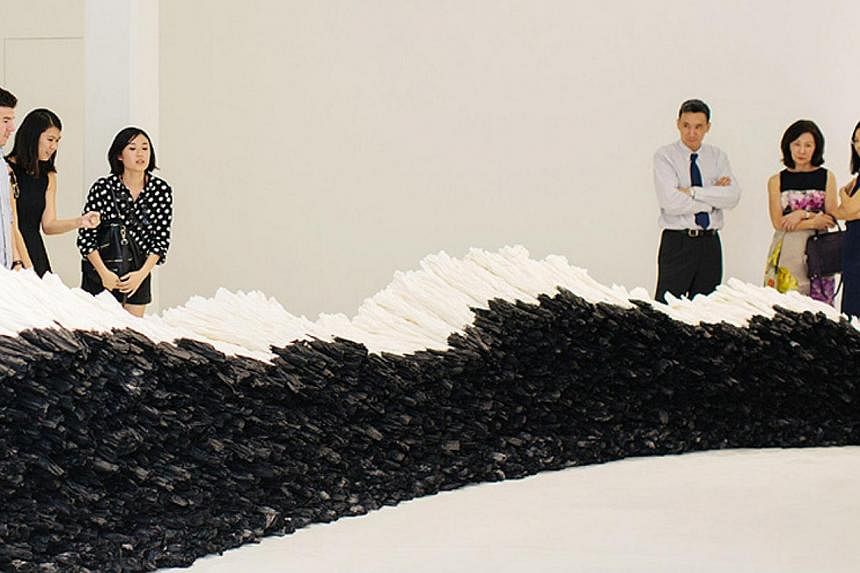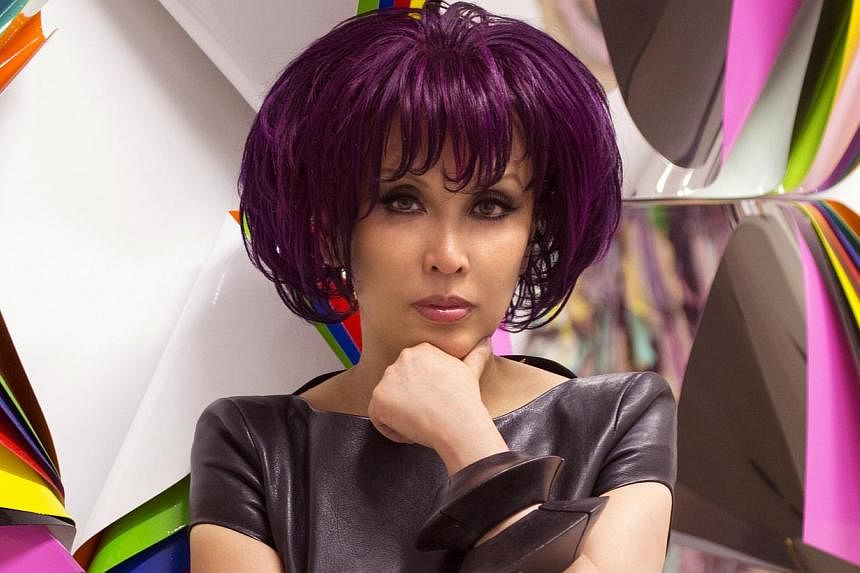Pearl Lam is reeling off what she ate for lunch.
"I had mee siiam, roti chaana and a doorean crepe and a doorean puff," she purrs, mangling the pronunciation of the local delicacies in her English boarding school- meets-Hong Kong socialite accent.
"I love dooorean," she adds, referring to the thorny fruit. "Tonight after dinner, I'm going to Gallang to have more doorean."
When told that it is pronounced Geylang and that it is known as a red-light district, the Hong Kong-born art dealer squeals: "Soooo cute!"
Named one of the top 25 women in the art world by artnet news, a global art market news wire, Ms Lam is sitting in her office in the spanking new Pearl Lam Galleries in Gillman Barracks. It is her fourth gallery; she has three others in Shanghai and Hong Kong.
All of 1.5m tall, the 45-year-old doyenne is wearing a pair of transparent five-inch wedges and a dramatic black dress with a jagged hem and billowy peek-a-boo sleeves. Completing the edgy look is a gravity-defying aubergine- coloured bob which sets off her aquiline nose, smoky eyes and bee-stung lips.
The flamboyant appearance presence is amplified by a voice which is as brassy and husky as it is loud. She grunts, groans, cackles and shrieks with no compunction.
Asked if she agrees with descriptions that she is a bit mad, she bellows: "Mad? No. I'm insane."
The apparent dizziness, however, belies a razor-sharp instinct which has made her a maverick and trailblazer in the contemporary Chinese art and design scene - she is not just a gallery owner, but also patron, collector and curator.
Her background is every bit as colourful as her appearance.
Her father was the Hong Kong real estate and media tycoon Lim Por Yen, who died in 2005 and who had seven children with four wives.
Ms Lam's mother Koo Siu Ying was Mr Lim's third wife. In 2002, her parents made the headlines when they split up and traded lawsuits over hundreds of millions of dollars.
At 12, Ms Lam was sent away to a boarding school in Brighton, England. She badly wanted to read art or architecture in university, but her plans were thwarted by her father who enrolled her for a degree course in accountancy and business at the University of Buckingham.
Her undergraduate days were wild, she lets on with girlish glee.
"There were five boys to one girl in my course. I got so much attention, it was crazy," says Ms Lam, who is single.
"I thought I'd go back and open a gallery, but my father said: 'I didn't send you away for you to become a shopkeeper.'"
Her mother, who had just started a company to develop a property in Shanghai, asked her to oversee the project.
"I had to slaaave," she says, emphasising the word. "I was like a Barbie doll for my parents; they twisted my arms."
The project - a block of luxury apartments - took seven years to build. But one good thing came out of being in Shanghai, Ms Lam says.
She discovered just how vibrant and exciting the Chinese contemporary art scene was.
"I was always referring to the West. I had no understanding of what Chinese art or culture was. But I started to realise all that I was passionate about - cross-discipline, poetry, painting, literature - was there. There were so many strands to Chinese art."
From 1993, she started organising pop-up art exhibitions in Hong Kong.
"The first show I did made me believe I should be doing art because I didn't feel like I was a zombie anymore. I felt the world was mine," she says.
Unfortunately, the Asian financial crisis struck in 1997 and her parents told her to stop her "frivolous" exhibitions. It was not until 2003 that she left the family business to pursue her passion in art.
Sars was responsible for changing her life. She was in Europe when the viral respiratory disease hit Hong Kong and could not return home for four months. During that time away, she decided she wanted to go into the art gallery business.
"My mother did not talk to me for nine months," she says.
That year, the French cultural attache in China approached her to curate a major exhibition, Awakening: La France Mandarin.
"Initially, it was supposed to be just a small space - 1,000 sq ft - but I ended up with 30,000 sq ft and 400 exhibits," she says of the exhibition which also travelled to Beijing, Hong Kong and Paris.
In 2005, she decided to open her first gallery Contrasts (now renamed Pearl Lam Galleries) so she could build a voice for art in China and Asia.
It helped that she had by then built up very solid credentials as a serious collector, patron and curator.
"I wouldn't call myself a collector. I would call myself a shopaholic," she says with a bellow. "I don't know how many pieces I have. I have collections everywhere - I never count them," says Ms Lam, who owns several museum-like homes including a 9,700 sq ft apartment in Shanghai and another huge residence - two Bond Street penthouses knocked into one - in London.
She readily concedes she is able to do what she does because of her wealth, but her privileged background also made it hard for her to sell art when she was starting out. "I don't like to sell, it's..," she leans in to whisper conspiratorially, "embarrassing."
An artist, however, took her to task one day. "He said: 'When you say something, people listen. But it's no good if you don't sell because we won't be able to live.'
"It took me a long time to understand selling is not degrading," says Ms Lam, who set up the China Art Foundation in 2008 to promote dialogue in art and culture between China and the world.
Singapore's strategic position in South-east Asia and its booming art scene prompted her to set up shop here earlier this year.
Like what she has done for China artists, she wants to take regional artists global.
With a dramatic sigh, she says there are many things she wants to do, like developing another property project.
But the priority is to turn Pearl Lam Galleries into one of the world's leading galleries. "Then I'll retire and I'll just buy art. Then, I'll create my own museum."
This story first appeared in the October 2014 issue of The Life e-magazine in The Straits Times Star E-books app, under the headline "Wild woman of art".


